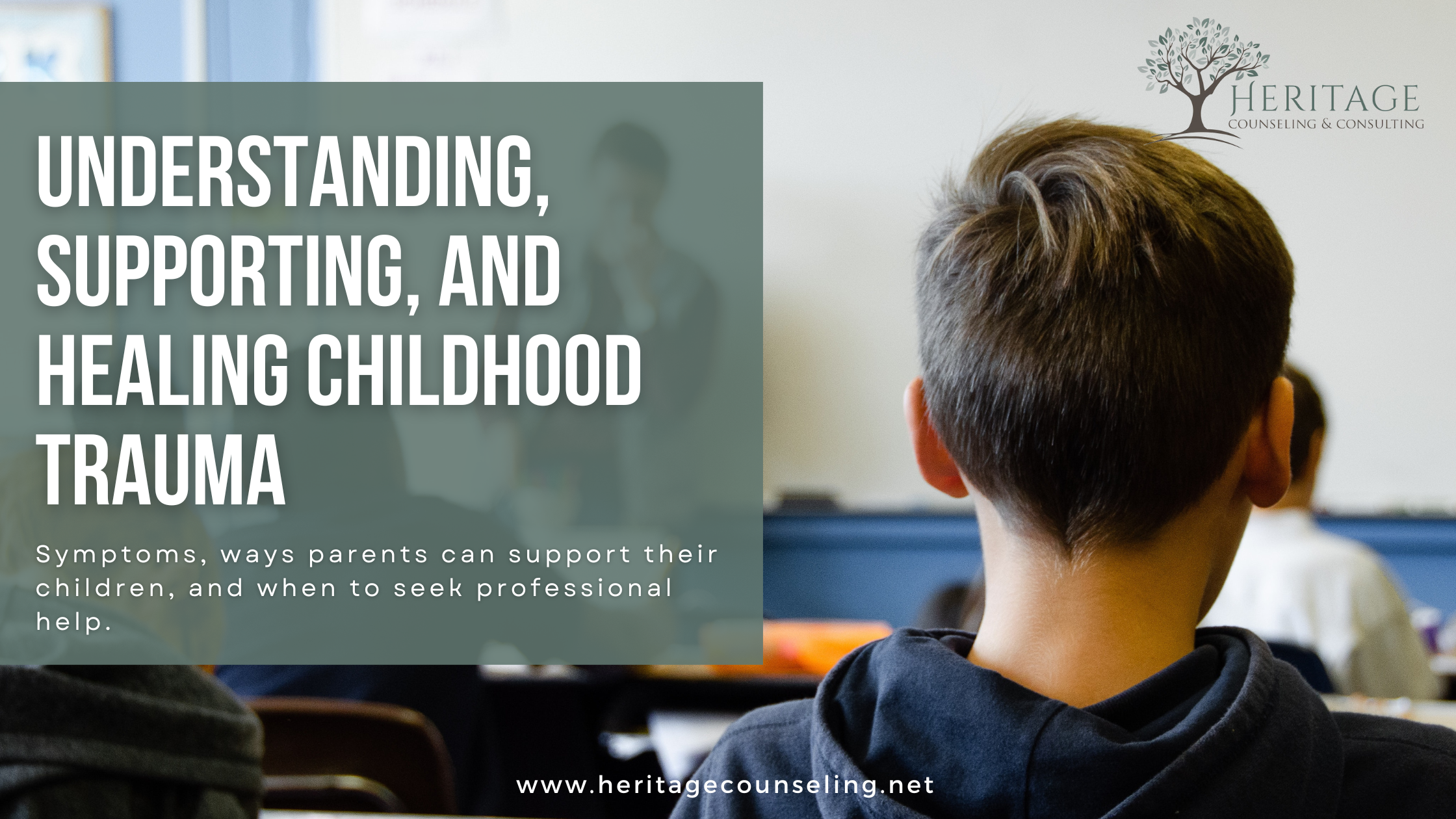“Childhood trauma” is a phrase that can evoke strong feelings, memories, sensations, and thoughts. Despite adults' best efforts, it is not uncommon for children to experience traumatic events during childhood and adolescence. In fact, research shows that more than 2/3rds of children have experienced a traumatic event by the age of 16. * As defined by the National Child Traumatic Stress Network, trauma is “any event or experience that leads to extreme emotional distress or psychological impairment”. It’s important to note that what one may consider a childhood trauma would not be traumatic for another individual. Traumatic stress occurs when violent or dangerous events overwhelm an individual’s ability to cope **. With this in mind, it may be easier to see that trauma can take on all shapes and sizes. This blog will provide a deeper understanding of childhood trauma and its origins, symptoms of trauma, how caregivers can help, and information about seeking professional support for people who have experienced childhood trauma.
Understanding Childhood Trauma
Trauma is a unique experience for every individual. What is traumatic for one person may not be traumatic for another. War, natural disasters, sexual assault, physical abuse, and the sudden loss of a loved one may be experiences that one would quickly categorize as traumatic. However, divorce or separation of caregivers, interpersonal conflicts, family financial stress, or events that leave an individual feeling isolated and disconnected can also be traumatic for children. Traumatic events can be a singular occurrence or ongoing, pervasive experiences.
Exposure to a traumatic event does not guarantee a trauma response. There are many factors that can safeguard or contribute to the resulting traumatic stress. When looking at the event itself it can be helpful to consider these questions:
What was the severity or intensity of the event? Did the event directly involve the child or did they witness it in person or through another source? (i.e. television, social media, hearing others talk about it). What happened immediately before and after the event? Relationships are another consideration when gauging the impact of the trauma. Were caregivers near? Did the child feel supported and understood by the important adults in their life? If adults were involved in the experience, how did they express and manage their feelings during and after the event?
The answers to these questions can help provide clarity when seeking to understand the impact of the experience. Children who have been exposed to prior traumatic events may be more likely to develop traumatic stress from subsequent experiences. This is because traumatic events modify and shape the way the body and the brain perceive and store information. Next, we will look at signs and symptoms that may indicate childhood trauma.
Recognizing Signs of Trauma in Children
It may be challenging to notice the symptoms of trauma in children. Children are still developing emotional regulation skills throughout childhood which can make it difficult to discern developmentally appropriate emotional dysregulation from trauma symptoms. However, childhood trauma symptoms tend to be recurrent and come with a significant change in behaviors, emotions, and physical manifestations. Depending on the age of the child and developmental level, some of the following symptoms may be observed.
Re-experiencing the event/subject through play or thoughts
Refusal or denial of the event happening
Change in eating habits
Change in sleep patterns, such as getting less or more sleep than usual or nightmares
Becoming extremely emotionally dysregulated when reminded of the trauma
Recurrent fear or sadness
Angry outbursts or irritability
Feeling depressed or alone
Hypervigilance to surroundings (being easily startled or difficulty attending to people/tasks)
Difficulty separating from caregivers
Withdrawing from a support system
Feeling depressed or alone
Change in grades or involvement at school
How Parents Can Help
Witnessing children who are struggling with trauma symptoms can be overwhelming and scary for parents and caregivers. Reaching out to a mental health professional for your child or your own reactions to the trauma can be a helpful tool. In addition to getting support outside of the family, these tips can be a helpful guide while navigating this time with your child.
Establish predictable routines A traumatizing experience can leave children feeling out of control and helpless to life. Establishing a consistent routine can help your child begin to feel a sense of normalcy and structure. Being able to anticipate what is next can alleviate the stress of childhood trauma experiences.
Invite Open Conversations Depending on a child’s development, there is a likelihood that they may take responsibility for the trauma. Having an open conversation with your child about the traumatic event and answering their questions while listening and validating their feelings can be very helpful. It’s important to note that if you cannot have this conversation without a strong reaction, that it’s better to be left to the professionals until parents can provide a regulated presence.
Teach Coping Strategies and Practice Them With Your Child It’s important that adults can model and practice engaging in coping and relaxation skills with their child after stressful situations. Building up a sense of safety and skills to regulate their emotional states will give them practice as they learn how to do it on their own. Movement, breathing exercises, body relaxation skills, and techniques can aid in healing. Connection after a traumatic experience is essential in the healing process.
The Importance of Seeking Professional Help
It can be difficult to know when one should seek out professional help after their child experiences something traumatic. Early treatment can positively impact all systems of the body and help children return their focus to positive social, emotional, and academic endeavors. Untreated traumatic stress can result in a multitude of physical and mental health challenges. If behavior doesn’t seem to have positive changes or if symptoms worsen, that can be a sign that professional assistance is needed. Additionally, if parents become overwhelmed or stressed that can be a sign to work with a professional.
There are many treatment options for children who have experienced trauma. Children ages 3-12 are good candidates for play therapy, which should be conducted by a trauma-informed play therapist. There, they can process their trauma and resulting thoughts and feelings through their play in a developmentally appropriate way. Another option for children is Neurofeedback, which is a treatment modality that does not require the child to talk about the traumatic event but is instead a tool that trains the brain to function more optimally and aids in central nervous system regulation which in turn can result in reduction of trauma symptoms. Traditional talk therapy is another treatment that can be helpful for older children and adolescents if they prefer to engage verbally. When it comes to trauma, getting help sooner is always better.
Developing a strong relationship with a counselor while providing your child with a safe and connected home environment can help teach your child about their resilience and strength. If it’s feeling difficult to navigate the world after childhood trauma don’t hesitate to reach out to Heritage Counseling to schedule a parent consultation and learn about treatment options at 214-363-2345.
Sources:
* https://www.samhsa.gov/child-trauma/understanding-child-trauma
https://www.nctsn.org/what-is-child-trauma/about-child-trauma
https://www.nctsn.org/what-is-child-trauma/trauma-types/complex-trauma/effects

